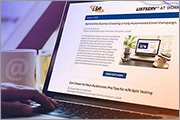Email Marketing: Improve Your Response Rates with Five Key Strategies
By Jani Kumpula and Susan Brown Faghani
L-Soft
Email communicators often wonder about benchmarks and how their open, click and conversion metrics stack up against others. But this type of comparison is not particularly useful because average response rates vary so widely across different industries and types of campaigns. Instead, focus on a few key best practices to more effectively engage your unique audiences.
Here are five quick tips to help you do just that:

 |
Obtain Subscribers Ethically |
When it comes to email marketing, ethical practices are crucial. Always use double opt-in to obtain explicit, prior consent from subscribers. Sending unsolicited email that puts the onus on the recipient to opt out is simply not worth the spam complaints and damage to your organization's reputation – not to mention the potential legal liabilities.
Include easy paths for people to subscribe to your email lists on your website and social channels. Clearly communicate what your list is about, what type of messages the subscriber will receive and how often. Also offer a preference or profile page at signup, allowing your subscribers to specify in detail what types of messages they want to receive. This initial data will serve as a cornerstone for any future segmenting that you do.
For additional encouragement, offer incentives – for example exclusive content, promotional items or discounts – that are not available to non-subscribers. And remember to include refer-a-friend opportunities in all of your communications, which will allow your lists to grow virally.
 |
Learn to Write Successful Subject Lines and Preheaders |
Crafting effective subject lines and preheaders is critical for email marketing success. Keep subject lines short and to-the-point (around 5-10 words and fewer than 50 characters). A preheader, which is a line of text at the very top of your message, can be slightly longer (up to 100 characters). Together, make sure that they convey a compelling reason for the subscriber to open your message.
Offer incentives or communicate a sense of urgency without sounding overly promotional. Personalization is also important to engage individual subscribers. What's great about subject lines and preheaders is that they are the easiest aspect of a campaign to test. Take advantage of A/B-split testing and see what resonates best with your target audience. Learn from your mistakes and implement positive outcomes to optimize future campaigns.
 |
Use Segmentation to Increase Relevancy and ROI |
Effective email marketing involves segmenting your subscribers into subgroups based on specific criteria. While it may seem logical that anyone who subscribes – and stays subscribed – to your email list is interested in your messages, data-driven specificity is crucial to retain and engage each subscriber. Consider parameters like demographics, geographic location and interaction history to segment your audience.
Prioritize your segmentation efforts based on your organization's goals and objectives. And remember, it's an evolutionary process, and you'll be refining and honing as you go, based on results. Beyond the basics of better open-up and click-through rates and fewer unsubscribes, using segmentation to bring relevant, relationship-building content to your subscribers can also enhance your overall ROI.
 |
Send the Right Content at the Right Time with Triggers |
Triggered campaigns are follow-up messages that are automatically sent out in response to specific subscriber behavior. For example, if a subscriber clicks through to your website from a previous campaign and abandons an item in the shopping cart, you can trigger a reminder message to be sent out after a certain amount of time has passed. Similarly, if a subscriber shows interest in a specific type of product, you can trigger future messages about similar products when applicable.
Unlike generic subscriber preferences, triggered campaigns take targeting a step further and provide insights into real-time subscriber interests. This enables you to deliver the right content at the right time when the subscriber is most receptive and likely to engage with you.
 |
Maximize Deliverability by Keeping Your List Clean |
Deliverability has become an important concept to ensure that messages are actually delivered to subscribers' inboxes instead of being blocked by ISPs or spam filters. After all, it doesn't matter how compelling your content may be if your subscribers never even receive the messages. Much of deliverability and reputation management revolves around keeping your list clean – meaning, not only deleting invalid email addresses to keep your bounce rate low but pruning subscribers who may no longer be interested in your messages.
Always include an easy one-click unsubscribe link in every message that you send. If subscribers can't easily unsubscribe, they are much more likely to click the "Report as Spam" or "Junk" button in their email clients. Needless to say, this negatively affects your sender reputation with ISPs and can lead to blacklisting. Also make sure that you're complying with key authentication standards like SPF, DKIM and DMARC, which are widely used to confirm that email messages originated from an authorized mail server.
 |
Next Steps |
LISTSERV is a registered trademark licensed to L-Soft international, Inc.
See Guidelines for Proper Usage of the LISTSERV Trademark for more details.
All other trademarks, both marked and unmarked, are the property of their respective owners.







